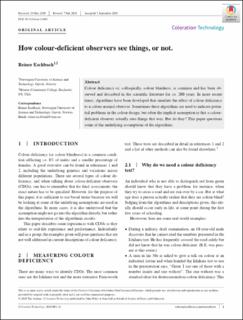| dc.contributor.author | Eschbach, Reiner | |
| dc.date.accessioned | 2022-04-20T06:09:56Z | |
| dc.date.available | 2022-04-20T06:09:56Z | |
| dc.date.created | 2021-11-25T12:44:22Z | |
| dc.date.issued | 2021 | |
| dc.identifier.citation | Coloration Technology. 2021, 137 (1), 29-32. | en_US |
| dc.identifier.issn | 1472-3581 | |
| dc.identifier.uri | https://hdl.handle.net/11250/2991395 | |
| dc.description.abstract | Colour deficiency or, colloquially, colour blindness, is common and has been observed and described in the scientific literature for ca. 200 years. In more recent times, algorithms have been developed that simulate the effect of colour deficiency to a colour-normal observer. Sometimes these algorithms are used to indicate potential problems in the colour design, but often the implicit assumption is that a colour-deficient observer actually sees things that way. But do they? This paper questions some of the underlying assumptions of the algorithms. | en_US |
| dc.language.iso | eng | en_US |
| dc.publisher | Wiley | en_US |
| dc.rights | Navngivelse-Ikkekommersiell 4.0 Internasjonal | * |
| dc.rights.uri | http://creativecommons.org/licenses/by-nc/4.0/deed.no | * |
| dc.title | How colour-deficient observers see things, or not. | en_US |
| dc.title.alternative | How colour-deficient observers see things, or not. | en_US |
| dc.type | Journal article | en_US |
| dc.type | Peer reviewed | en_US |
| dc.description.version | publishedVersion | en_US |
| dc.source.pagenumber | 29-32 | en_US |
| dc.source.volume | 137 | en_US |
| dc.source.journal | Coloration Technology | en_US |
| dc.source.issue | 1 | en_US |
| dc.identifier.doi | 10.1111/cote.12494 | |
| dc.identifier.cristin | 1958982 | |
| cristin.ispublished | true | |
| cristin.fulltext | original | |
| cristin.qualitycode | 1 | |

